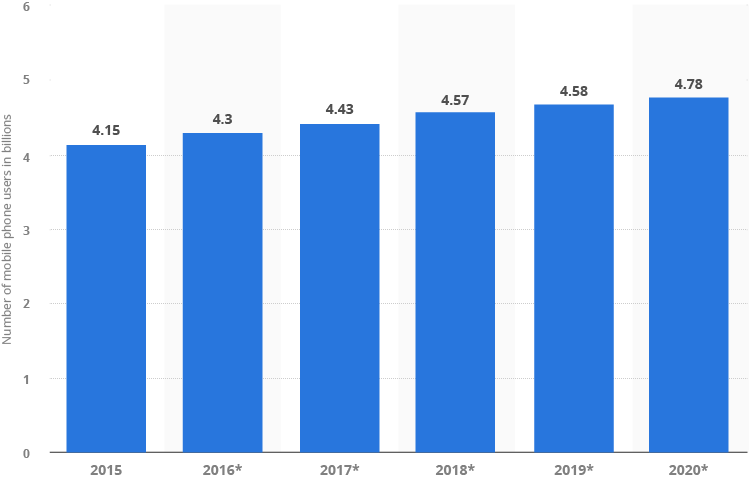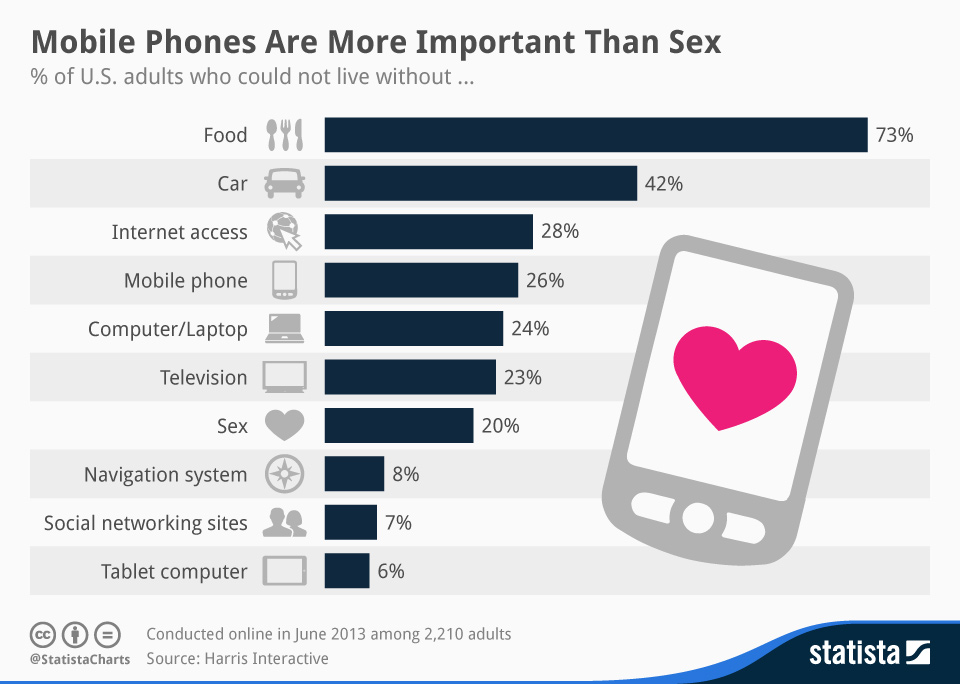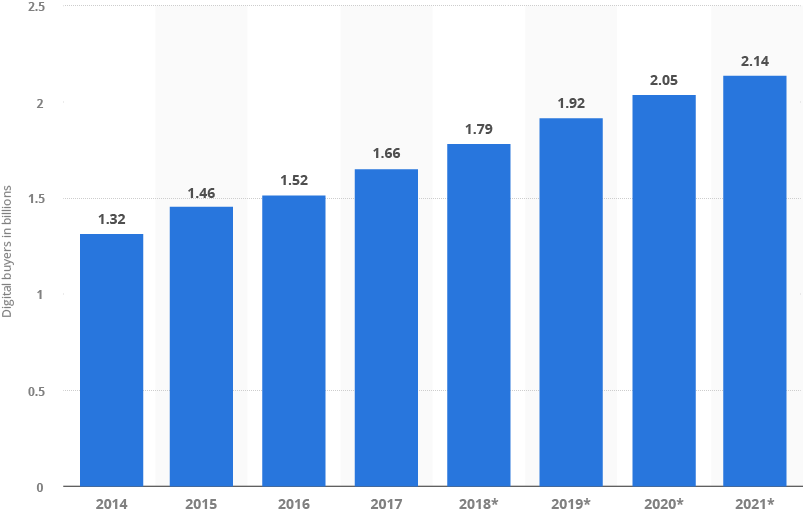The glory of mobile phones is undeniable, as the tiny devices have paved their way right into our lives and hearts. Not a goes day by when users don’t spend at least a couple of hours on their phones, scrolling around several apps. 94% of Americans already own a mobile phone and an average user checks the phone more than 150 times a day.
The massive adoption of mobile phones opens doors to unlimited business opportunities. With growing mobile phone users, companies have higher chances of efficiently approaching their target market. According to Statista, 4.78 billion people will use mobile phones by 2020.

It’s been a while since the intimacy with mobile phones heightened. In 2014, Statista published a report on the importance of mobile phones for American adults. 26% found life difficult without mobile phones while only 20% found sex integral (Now that’s some insight).

According to Bank of America’s Trends in Consumer Mobility Report of 2018, 70% of people access their bank’s mobile application for transactions and 95% of them believe it saves times.
Have a look at this infographic from the report.
The enhanced addiction to mobile phones is a wonderful opportunity for retail businesses. If an average user interacts with his phone over 50 times a day, isn’t it the best platform to exploit?
Read More:How to Develop an On-Demand Delivery App
The Need for E-Commerce Mobile Apps
The transition from traditional operations to online platforms was witnessed in the last few years when companies started selling online.
According to Statista, the number of online buyers increased from 1.32 billion in 2014 to 1.79 billion in 2018 and will reach 2.14 billion in 2020.
 Online platforms became the talk of the town for the monstrous convenience they bring along. However, mobile commerce takes the game to a whole new level. Users can enjoy the retail experience easily on the device that stays in their hand almost all the time. Thus, 49.2% of total e-commerce sales in the United States, in 2020, will constitute m-commerce.
Online platforms became the talk of the town for the monstrous convenience they bring along. However, mobile commerce takes the game to a whole new level. Users can enjoy the retail experience easily on the device that stays in their hand almost all the time. Thus, 49.2% of total e-commerce sales in the United States, in 2020, will constitute m-commerce.
Mobile commerce offers infinite benefits for businesses and their clients. The statistics above confirm that people prefer using their mobile phones over any other device. Today’s smart smartphones offer almost everything that a desktop does and more.
Since the device is with the user at all times, it is easier to push notifications at different times. Research shows that most online sales take place around 8:00 pm during on Sundays and Mondays. Thus, you know when to push the sale alert knowing that it will reach the user at just the right time.
Shopping via mobile phones is easier and convenient. It doesn’t require extra efforts for users to visit websites, instead feels like any other app scrolling. It also allows companies to integrate marketing efforts based on customers’ preferences and interests best evaluated from their mobile behaviour.
More businesses are realizing the need for active mobile commerce to better engage and retain customers.
How to Shift to Mobile Commerce from an E-Commerce Website?
The thought of shifting from an e-commerce platform to a mobile app can be overwhelming. However, the transition is made smooth through different supporting platforms. Both, your e-commerce website and mobile application will share the same database. So, you don’t have to worry about establishing a new data center. However, the data will be presented differently on each platform.
Start by knowing which platform to exploit for your mobile app. Different platforms support the conversion of an e-commerce website to a mobile app, aided by Content Management Systems. Some of the popular channels include WooCommerce and WordPress.
Now that you have an established website, it isn’t difficult to have a mobile app too. However, you will require Application Programming Interfaces to exchange the data with the mobile app. Some information remains static, such as size chart, while other is pulled by the API, such as product availability.
Make sure that your mobile app meets quality standards and is meticulously tested. Once you are sure of the functionality, distribute it via stores like the Google Play Store and Apple App Store.
Furthermore, your website and mobile app should feel the same. The transition should be from one platform to another, and not from one brand persona to another. You will lose potential customers, even loyal customers, if your mobile app doesn’t immediately resonate with your website.
Essential Functionality of Mobile Commerce Apps
Let’s explore the important features of an e-commerce mobile app. These features determine the overall shopping experience of the users.
Mobile commerce apps offer an end-to-end user experience through high-end functionality and pleasing aesthetics
User Profiles:The mobile app allows users to register their profiles on the app. To offer convenience to the users, the apps offer social logins allowing people to register with Facebook or other social platforms. Social authorization is aided by authorization protocols such as oAuth. Other authorization of user profiles is aided by API.User profiles allow people to register with the app so its easier to shop every time, without having to enter the details.
Product Categories:Mobile commerce apps assign unique identities to each product in the database. Every product has a title, product details, and price, along with other details. Unique identities are assigned to every category.The categories help users find their desired product easily.
Shopping Cart:Interested products are proceeded for purchase by adding them to the shopping, just like you add products in the cart during grocery shopping. Once the products are added, customers can either continue shopping or proceed to checkout.The shopping behavior of customers gives insights into your future marketing efforts. For example, you might want to remind people who added products in the cart but didn’t complete the purchases. Similarly, you can customize your campaigns by pushing product categories that users are inclined towards.
Order Tracking:Human beings want instant gratification. The idea of receiving the order sometime later is a major turnoff for people. However, order tracking reduces the frustration of waiting for the parcel and allows customers to check the status.Customers can be notified by using SMS gateways that send messages from the browser. You can notify them when the parcel is ready for delivery, leaves the warehouse, is off for delivery, and so on.
Payment Methods:Let customers make the payments via different methods, such as credit/debit card, cash on delivery, and so on. Platforms like Braintree, PayPal, and Stripe are great payment gateways as they endorse several payment methods.
Customer Support:No shopping experience is smooth without supportive and helpful customer support. Make it easier for customers to get information via online chat or email.
How Can Cubix Commerce Help?
Cubix Commerce is a one-stop solution that serves as an efficient marketplace for businesses. Its excellent features provide a complete remedy to your mobile commerce needs.
Cubix Commerce provides a completely customized mobile commerce solution for iOS, Android, and Hybrid platforms. It’s high-tech functionality and easy user interface facilitates businesses to effectively manage.
Some of its key features include inventory management, packaging management, product management, distribution management, content management system, extensive payment methods, order tracking, and more.
Mobile commerce is the need of the day. Businesses must allow customers to enjoy the shopping experience while staying in their comfort zones. Get closer to your customers through robust mobile apps!

